Three facts, to begin with:
1. I've never tablet woven anything before.
2. My deadline is in exactly 10 days now.
3. I'm starting with about 40 inches of brocaded tablet weaving, because go big (er...minuscule and obsessive) or go home.
Super Bonus Fact: I don't have a proper set-up for winding bobbins of thread, let alone multiple as-close-to-identical-as-possible bobbins.
I have never in my life let a lack of proper tools or the inflexibility of the time-space continuum (and my place in it) get in the way of attempting something mad and interesting, and I'm not about to start now. On with the weaving!
 |
| That poor abused knitting needle. I don't think I've knit with it since the project I bought that set for; I've wound a lot of yarn with it, though. |
As for the tools I
do have, there is a spinning wheel and three associated bobbins, a number of bobbins presumably from spinning frames in Massachusetts textile mills (thanks, Grandma!), a size 4 knitting needle that works pretty well as an axle for said bobbins, and a swift, the clamp for which has just crept into frame at the lower right of the photo up there.
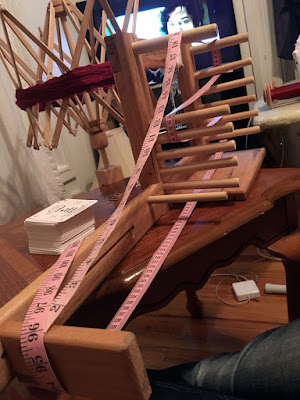 |
| Quite a bit longer than I really need, but that's a good thing. |
Oh yeah, there's a loom and a stack of cards, too. There's the swift in the background, and further back is Anna Karenina having an argument for probably only the second time of the night, at this point. As movies to have on in the background go, this is absolutely one of my favorites: no matter when you look up, there's something gorgeous happening onscreen, and the music is wonderful and the actors are all brilliant with their voices so just
listening is a pleasure.
Back to the weaving. As a warp-faced structure, tablet weaving
eats warp length for breakfast. And lunch, and dinner, and probably snacks on it between meals, too. Generally you're advised to put on at least half again the projected completed length of the project, and more won't hurt, especially for longer pieces. I need something like a 44-inch piece for the waistband, so 96 inches is a little overkill, but I'm also assuming there will be some unusable sampling at the beginning. I may also discover that I need a longer waistband than I'm predicting (have to finish the collar so I can attach sleeves so I can lace the bodice
so I can find out if my shoulders will fit through the space I'm planning to leave them) which would throw a monkey wrench into the whole business, but at least this way I won't have to rewarp anything.
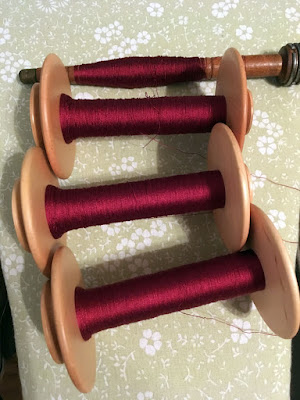 |
| Sing with me! One of these things is not like the others~ |
I used the very scientific method of eyeballing it to wind these bobbins, and the top one didn't want to turn on the wheel at all, no matter how I adjusted the drive band. That one I stopped winding when I was tired of coaxing it and the thread conveniently ended for me. Easy decision (and a fateful one, as you'll see later). The other three wound on just fine, and I tried to get about the same amount of thread on each.
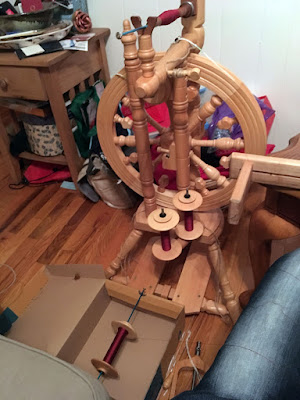 |
| Poor abandoned flyer on the floor. I have a habit of using fiber arts tools for anything other than what they're meant to do. |
To warp the loom, I set up two bobbins on the wheel's attached lazy kate, one propped up by the maiden (up top), and one on my trusty Shoebox O' Spinning Wheel Things, which guards the accessories from the cats. Not the neatest possible solution, but there are much worse ones, and I didn't have a long-suffering friend handy to use as bobbin management.
The stack of cards I rested in my lap, and the loom was sideways in front of me, within easy reach for wrapping the warp around the pegs. The cat was behind me, oozing closer every time she thought I wasn't paying attention.
 |
| That's the orifice hook for the wheel. Very convenient, and pretty close to the stated purpose of the tool. |
After I counted out my cards (81) I threaded them, running the threads as straight as possible from their bobbins to the pack of cards. Tablet weaving involves a lot of wear on the threads, so the more protected they are to begin with, the better.
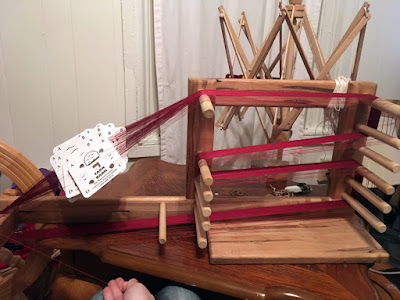 |
| Anna Karenina is restarting about now. |
Speed warping! Admittedly, this is a
lot faster than threading each individual card and tying off the threads would have been, but "speed" is a questionable descriptor. You keep the pack of threaded cards somewhere they won't fall over or get out of order, and release one at a time to suspend in the working space of the loom. Wind the warp threads around the appropriate pegs, and when you get back to the beginning, release another card. It's not difficult, but it is a little painstaking pulling the threads through the entire pack of cards and keeping the bobbins from unreeling too wildly and tangling.
 |
| I think these threads are thinner than the threads in my jeans. |
I ran out of thread on the spinning frame bobbin two cards from the end. I looked forlornly at the bobbin, and at the cards, and at my pattern, and decided I could just remove a card on either side of the center motif. I'd included two-card borders to separate the center from the edge motifs, but one-card borders would also work—and that way I wouldn't need to wind and join a new strand just to add those last two cards.
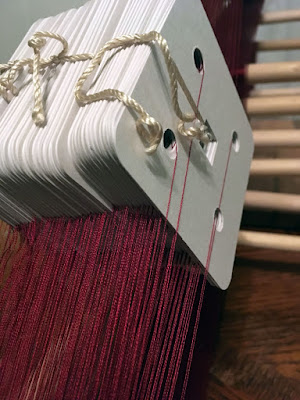 |
| This photo has been heavily edited. The light in my apartment is never that clear white. |
I threaded the ties from the skein of silk through the center holes of the cards in three packs, because the ties weren't long enough to reach through all 81 at once. Safely tied, the whole loom was deposited in my bathroom with the door shut, to guarantee no feline shenanigans overnight.
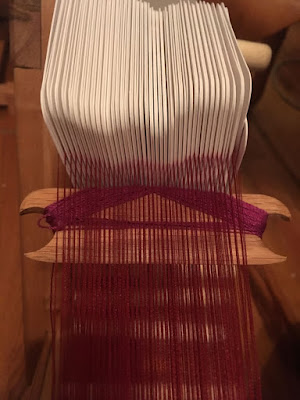 |
| Being arteestic again. Arrays of warp threads are just so tempting. |
The next night, I found a shuttle wound with purple crochet cotton (I think) to do a little test weaving, just to get familiar with how the cards turn and how tightly to pack the threads.
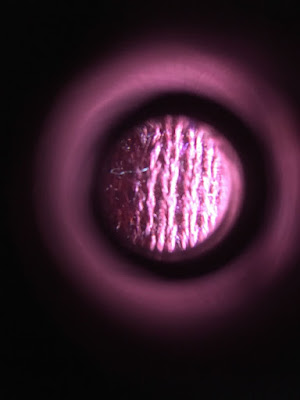 |
| Enter the W E A V I N G Z O N E. |
Not too bad! This photo is pretty blurry, and someday I need to get out the other camera so I can take a photo of what it looks like when I'm shooting through the tiny magnifier to get these cool close-ups, but I think it's clear enough to see what's going on.
The tiny chevrons that almost look knitted are the warp threads; they pass through the cards alternating front-to-back and back-to-front (and there are better explanations out there with diagrams and everything, so I'm not going to go into that here), which makes them twist in opposite directions as well. And then you get a ground fabric that looks remarkably like knitting. You can also see the purple weft thread through a few gaps between the warp threads, and that's a sign that I'm not packing them close enough yet. The weft should ideally be invisible except in tiny loops at the very edges of the band.
 |
| I really do love how almost-abstract this is. |
After more experimenting with tension on the warp and weft, I got to this! Not only is it a better photo, but the warp threads are locking together more neatly and the weft is completely invisible.
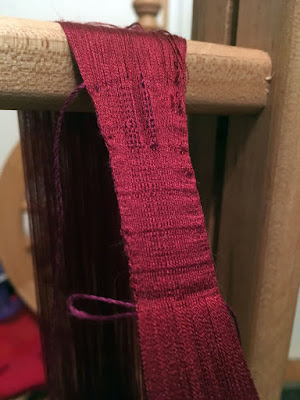 |
| Weird angle because the loom is standing on end—the top is what's normally closest to me as I weave. |
And here's what the band looks like! You can see the point where I started snugging up the weft more, which brought the width of the band down to 1.9cm. Narrower than I'd expected, with this many cards, but still wide enough for its job. The periodic horizontal marks are where I changed the direction I was turning the cards, effectively making a double row where the same threads stay on the surface of the band. It's a subtle effect, but I like it a lot. I'm interested to see how noticeable it is with brocading over top.












Comments
Post a Comment